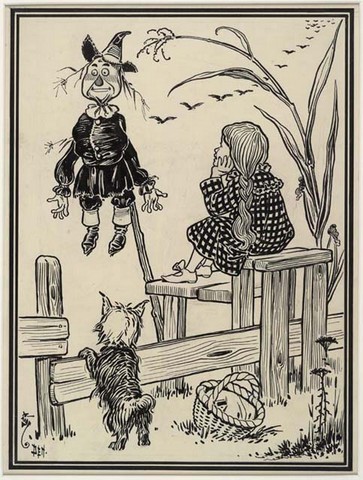Adventure! Newfangled flying machines! This book has it all! This post originally appeared here on December 3, 2013.
Lately I’ve been reading my way through the series of Oz books. The Wonderful Wizard of Oz is only the first in a series of 14 books, and it’s not remotely the best.
It’s fascinating to reread books I loved as a child. Some are still great. Others have inexplicably morphed into poorly-written, preachy duds. Fortunately, the Oz books are the former type. They were published between 1900 to 1920 and vary in quality, but the made-up world is fun and Baum’s sense of humor holds up well.
In The Patchwork Girl of Oz, the seventh book in the series, I was surprised—and pleased—to encounter a bit of science. Even better, it’s totally outdated science.
In the book, Dorothy and her companions go on a quest to revive some people who have been turned to marble. One of the ingredients they need is water from a dark well, which they seek inside a mountain where two tribes live in a vast cave.
When the travelers enter a house, they find something amazing: The room dazzles, “for it was lined throughout with an exquisite metal that resembled translucent frosted silver” and radiates soft light.
“That’s radium,” explains the Chief. “We Horners spend all our time digging radium from the mines under this mountain, and we use it to decorate our homes and make them pretty and cosy. It is a medicine, too, and no one can ever be sick who lives near radium.”
In 1913, when the book was published, radium must have seemed like a magical metal from a fantasy world. The element had been discovered only 15 years before, and isolated for the first time in 1910. It wasn’t clear yet how badly people could be hurt by its radioactive glow.
At another point, the group throws the Patchwork Girl over a fence, and she uses the word “volplaned” to describe her flight. The New Oxford American Dictionary defines “volplane” as “a controlled dive or downward flight at a steep angle, esp. by an airplane with the engine shut off.” It’s an early-20th century word from the French “vol plané,” which means “glided flight.”
The Wright brothers’ Flyer had only made its first flight a decade before, in 1903. Apparently the vocabulary of this new technology hadn’t settled in yet.
It’s crazy that these books, which are perfectly relatable and written in modern language with a modern sense of humor, were of a time when “volplane” was a new, exciting, and relevant word and “radium” was a new, exciting, and wonderful element.
More than acquainting me with century-old science and technology, though, these books put me in touch with my younger self.
The Oz books have contributed to a lifelong sense that something amazing is waiting behind every corner. Dorothy and her friends went into a mountain and found a land where the houses glow. I think a tiny part of me is still waiting to be whisked off to hang out with Dorothy and Princess Ozma. (Forget the Wizard—in the later books, Oz gets a girl monarch.) Roald Dahl’s books find weirdness at every normal-seeming turn. In the books of Daniel Pinkwater, a wrong turn could bring you to a strange world of all-night food. To this day, I’m a little disappointed when I realize that the forest behind a house just stretches as far as the next street.
Science has some of that sense, too. Amazing discoveries are happening all the time. You never know–there could be a radium house in the next block. We’d better go look.
Art: Wikimedia commons
